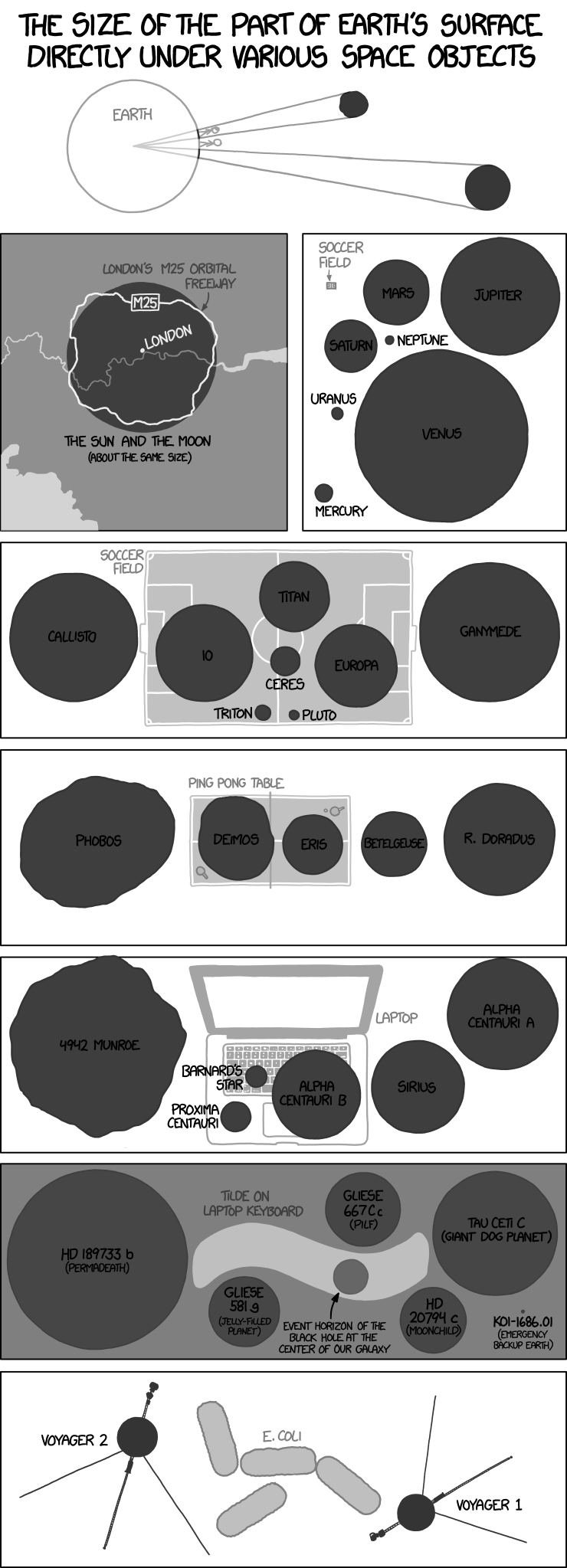October 11, 2013
#1276: Angular Size explain

The size of the part of Earth’s surface directly under various space objects
[Several images are shown, of space objects of differing size and at different distances from Earth, illustrating the differing sizes of their “shadows” as mapped onto Earth’s surface viewed from the center of the Earth.]
[The first image merely sets the stage: Earth is a full circle, with two figures — Cueball and Megan — standing on it; a small space object casts a “shadow” on Megan, while a slightly larger object, though proportionally farther away, casts just about the same size shadow next to Cueball.]
[The second image is a map showing London, with the Thames running through it, and a ring highway running around it labeled “London’s M25 Orbital Freeway”. A grey circle is overlaid, just about the diameter of the M25; it is labeled “The Sun and The Moon (about the same size)”.]
[The third image has a small grey rectangle in one corner labeled “Soccer field” for comparison. The image is dominated by four large, grey circles, considerably larger than the soccer field, labeled “Saturn”, “Mars”, “Jupiter”, and “Venus”, with Mars slightly larger than Saturn, Jupiter approximately twice the diameter of Saturn, and Venus approximately three times the diameter of Saturn. Smaller circles are labeled “Mercury”, “Uranus”, and “Neptune”, with Mercury still somewhat larger than the soccer field, Uranus about its size, and Neptune slightly smaller.]
[The fourth image has the soccer field blown up to take up much of the view; its center circle, goal areas, and corner kick areas are visible. Labeled grey circles of various circles are again overlain: Callisto and Ganymede are about as large as one half of the field; Io, Titan, and Europa are somewhat smaller than half the field; and Ceres, Triton, and Pluto are much smaller (all three together would probably fit into the soccer field’s center circle).]
[In the fifth image, there is a different grey rectangle, this one labeled “Ping Pong table”, with a few balls and paddles visible. An irregular ovoid labeled “Phobos” is about the size of the table, as is a circle labeled “R. Doradus”. An irregular circular shape labeled “Deimos” is about the size of half the table; a circle labeled “Betelgeuse” is a little smaller, and a circle labeled “Eris” is a little smaller, though still comfortably filling most of half of the table.]
[In the sixth image, a light grey image of laptop computer keyboard and screen is shown, viewed from directly above. An irregular shape labeled “4942 Munroe” is slightly larger than the laptop, while circles labeled “Alpha Centauri A”, “Sirius”, and “Alpha Centauri B” form a descending series somewhat smaller than it. Circles labeled “Proxima Centauri” and “Barnard’s Star” are considerably smaller than the laptop: Proxima Centauri would fit on the trackpad, while Barnard’s Star covers perhaps four keys on the keyboard.]
[In the seventh image we see a greatly zoomed-in shape which is identified as the “Tilde on laptop keyboard”. A circle labeled “HD 189733 b (permadeath)” is almost as large as the tilde is wide; a circle labeled “Tau Ceti C (giant dog planet)” is somewhat smaller. Circles labeled “Gleise 581 g (jelly-filled planet)”, “Gleise 667 C c (PILF)”, and “HD 20794 c (moonchild)” are all 1/2 to 1/3 as wide as the tilde is wide. A smaller circle labeled “Event horizon of the black hole at the center of our galaxy” fits comfortably within the tilde’s stroke width. A very small dot off in one corner (much smaller than the tilde or anything else in the image) is labeled “KOI-1686.01 (emergency backup earth)”.]
[Finally, in the eighth image, the size comparison is to the grey outlines of four bacilliform bacteria labeled “E. coli”. The outlines of two interstellar probes are shown, with circular main housings and protruding instruments and antennae. They are labeled “Voyager 1” and “Voyager 2”.]